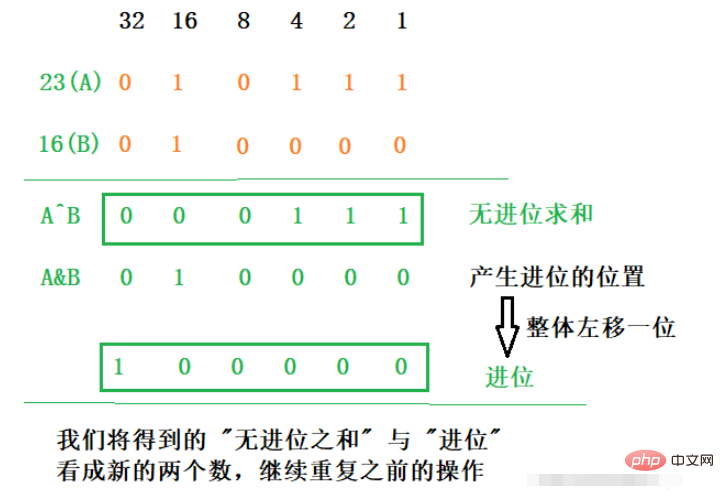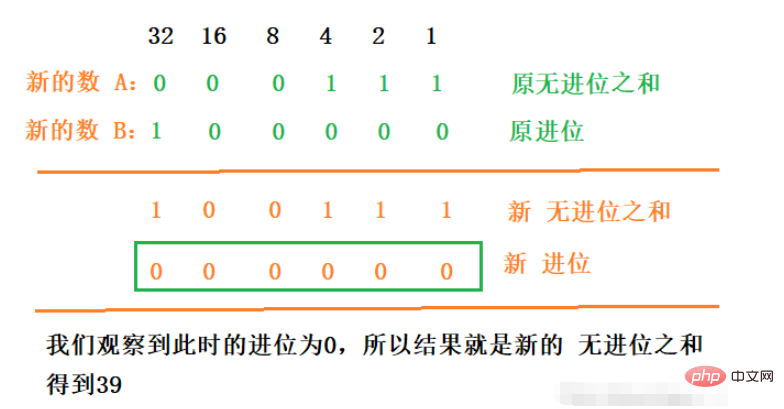How to implement summation in Java without arithmetic operators

The question says that arithmetic operators cannot be used, so we can only start with logical operators and shift operators.
We know that the ^ (XOR) operation is a carry-free sum of two numbers. If the addition of two numbers does not produce a carry, then the sum is the sum of the two numbers. This is the key to solving the problem. Generally speaking, adding two numbers will produce a carry. To get the correct sum, we should add a carry on the basis of the "sum without carry". Then we should first get the carry. We know that when the corresponding positions of the two numbers are both 1, a carry will occur. That is, under the condition that the corresponding positions A&B==1, we can get a carry for each bit, but the carry is to add this 1 to the corresponding higher digit, so we shift the obtained carry to the left by one digit, and then add it to the "sum without carry" obtained previously, to get the sum of the two numbers.
We find that we can have infinite matryoshka dolls here. To get the sum of "sum without carry" and "generated carry", then treat these two numbers as two new numbers respectively. For Its summation. The previous operation is also repeated until the two numbers cannot produce a carry, and the result can be obtained directly through the ^ operation.
Suppose we find the value of 23 16


public static int addAB(int A, int B) {
// 当两数的产生的进位为 0,就退出循环,返回其无进位和,就是结果
while ((A & B) != 0) {
int A_B = A ^ B;// 无进位求和
int AB = (A & B) << 1;// 得到进位
// 接下来就是求 得到的进位 + 无进位之和,重复前面的操作,直到不产生进位
A = A_B;
B = AB;
}
// 最后返回新的无进位之和
return (A ^ B);
}public static void main(String[] args) {
int count = 1_0000_0000;// 比较次数 100000000次
Random random = new Random();// 生成随机数字
boolean flag = true;// 相等则为 true
for (int i = 0; i < count; i++) {
int num1 = random.nextInt(Integer.MAX_VALUE/2);// 随机正数1
int num1_2 = random.nextInt(Integer.MAX_VALUE/2);// 随机正数2
// 随机正数1 + 随机正数2
if ((num1+num1_2) != addAB(num1,num1_2)){
// 有一次不相等的,则退出循环
flag = false;
break;
}
int num2 = -random.nextInt(Integer.MAX_VALUE/2);// 随机负数1
int num2_2 = -random.nextInt(Integer.MAX_VALUE/2);// 随机负数2
// 随机负数1 + 随机负数2
if ((num2+num2_2) != addAB(num2,num2_2)){
// 有一次不相等的,则退出循环
flag = false;
break;
}
int num3 = random.nextInt(Integer.MAX_VALUE);// 随机正数
int num4 = -random.nextInt(Integer.MAX_VALUE);// 随机负数
// 随机正数 + 随机负数
if ((num3+num4) != addAB(num3,num4)){
// 有一次不相等的,则退出循环
flag = false;
break;
}
}
System.out.println(flag);
}
The above is the detailed content of How to implement summation in Java without arithmetic operators. For more information, please follow other related articles on the PHP Chinese website!

Hot AI Tools

Undresser.AI Undress
AI-powered app for creating realistic nude photos

AI Clothes Remover
Online AI tool for removing clothes from photos.

Undress AI Tool
Undress images for free

Clothoff.io
AI clothes remover

Video Face Swap
Swap faces in any video effortlessly with our completely free AI face swap tool!

Hot Article

Hot Tools

Notepad++7.3.1
Easy-to-use and free code editor

SublimeText3 Chinese version
Chinese version, very easy to use

Zend Studio 13.0.1
Powerful PHP integrated development environment

Dreamweaver CS6
Visual web development tools

SublimeText3 Mac version
God-level code editing software (SublimeText3)

Hot Topics
 1666
1666
 14
14
 1426
1426
 52
52
 1328
1328
 25
25
 1273
1273
 29
29
 1254
1254
 24
24
 Break or return from Java 8 stream forEach?
Feb 07, 2025 pm 12:09 PM
Break or return from Java 8 stream forEach?
Feb 07, 2025 pm 12:09 PM
Java 8 introduces the Stream API, providing a powerful and expressive way to process data collections. However, a common question when using Stream is: How to break or return from a forEach operation? Traditional loops allow for early interruption or return, but Stream's forEach method does not directly support this method. This article will explain the reasons and explore alternative methods for implementing premature termination in Stream processing systems. Further reading: Java Stream API improvements Understand Stream forEach The forEach method is a terminal operation that performs one operation on each element in the Stream. Its design intention is
 PHP: A Key Language for Web Development
Apr 13, 2025 am 12:08 AM
PHP: A Key Language for Web Development
Apr 13, 2025 am 12:08 AM
PHP is a scripting language widely used on the server side, especially suitable for web development. 1.PHP can embed HTML, process HTTP requests and responses, and supports a variety of databases. 2.PHP is used to generate dynamic web content, process form data, access databases, etc., with strong community support and open source resources. 3. PHP is an interpreted language, and the execution process includes lexical analysis, grammatical analysis, compilation and execution. 4.PHP can be combined with MySQL for advanced applications such as user registration systems. 5. When debugging PHP, you can use functions such as error_reporting() and var_dump(). 6. Optimize PHP code to use caching mechanisms, optimize database queries and use built-in functions. 7
 PHP vs. Python: Understanding the Differences
Apr 11, 2025 am 12:15 AM
PHP vs. Python: Understanding the Differences
Apr 11, 2025 am 12:15 AM
PHP and Python each have their own advantages, and the choice should be based on project requirements. 1.PHP is suitable for web development, with simple syntax and high execution efficiency. 2. Python is suitable for data science and machine learning, with concise syntax and rich libraries.
 PHP vs. Other Languages: A Comparison
Apr 13, 2025 am 12:19 AM
PHP vs. Other Languages: A Comparison
Apr 13, 2025 am 12:19 AM
PHP is suitable for web development, especially in rapid development and processing dynamic content, but is not good at data science and enterprise-level applications. Compared with Python, PHP has more advantages in web development, but is not as good as Python in the field of data science; compared with Java, PHP performs worse in enterprise-level applications, but is more flexible in web development; compared with JavaScript, PHP is more concise in back-end development, but is not as good as JavaScript in front-end development.
 PHP vs. Python: Core Features and Functionality
Apr 13, 2025 am 12:16 AM
PHP vs. Python: Core Features and Functionality
Apr 13, 2025 am 12:16 AM
PHP and Python each have their own advantages and are suitable for different scenarios. 1.PHP is suitable for web development and provides built-in web servers and rich function libraries. 2. Python is suitable for data science and machine learning, with concise syntax and a powerful standard library. When choosing, it should be decided based on project requirements.
 PHP's Impact: Web Development and Beyond
Apr 18, 2025 am 12:10 AM
PHP's Impact: Web Development and Beyond
Apr 18, 2025 am 12:10 AM
PHPhassignificantlyimpactedwebdevelopmentandextendsbeyondit.1)ItpowersmajorplatformslikeWordPressandexcelsindatabaseinteractions.2)PHP'sadaptabilityallowsittoscaleforlargeapplicationsusingframeworkslikeLaravel.3)Beyondweb,PHPisusedincommand-linescrip
 PHP: The Foundation of Many Websites
Apr 13, 2025 am 12:07 AM
PHP: The Foundation of Many Websites
Apr 13, 2025 am 12:07 AM
The reasons why PHP is the preferred technology stack for many websites include its ease of use, strong community support, and widespread use. 1) Easy to learn and use, suitable for beginners. 2) Have a huge developer community and rich resources. 3) Widely used in WordPress, Drupal and other platforms. 4) Integrate tightly with web servers to simplify development deployment.
 PHP vs. Python: Use Cases and Applications
Apr 17, 2025 am 12:23 AM
PHP vs. Python: Use Cases and Applications
Apr 17, 2025 am 12:23 AM
PHP is suitable for web development and content management systems, and Python is suitable for data science, machine learning and automation scripts. 1.PHP performs well in building fast and scalable websites and applications and is commonly used in CMS such as WordPress. 2. Python has performed outstandingly in the fields of data science and machine learning, with rich libraries such as NumPy and TensorFlow.




